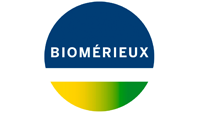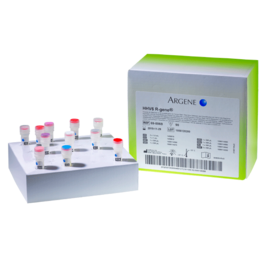HHV6 R-GENE®
Real-time PCR kit for the detection and quantification of Human Herpes Virus 6 (HHV6) DNA
- Reliable quantification of HHV-6A & HHV-6B without subtyping
- Ready-to-use kit including internal control and quantification standards
- Validated on major extraction and amplification platforms as well as on most relevant specimen types
Benötigen Sie weitere Informationen?
HHV6 R-GENE® advantages
Human herpesvirus 6 (HHV-6) can cause various clinical syndromes including severe infections in immunocompromised patients, particularly in allogeneic hematopoietic stem cell transplant (HSCT) recipients. HHV-6 reactivation has been associated with numerous post-transplant complications including graft-versus-host-disease, encephalitis, interstitial pneumonitis, delayed engraftment, fever, and skin rash, responsible for morbidity and mortality. HHV-6 DNA detection and quantification is useful for diagnosing and monitoring infections.
HHV6 R-GENE® offers rapid and specific detection even prior to clinical symptoms, making it an ideal solution. This helps improve options for management, measure the effectiveness of treatment, and monitor for relapse.
- Sensitive and reproducible
- Reliable measurement of HHV6 infection
- Wide linear range
- Standardized
- Uniform processing within ARGENE® Transplant range of products
- Harmonized test profiles for multiple assays in one run
- Flexible
- Validated on most relevant specimen types
- Validated with major extraction and amplification platforms
- For use on manual workflow or on automated workflow ARGENE® SOLUTION
Everything you need in one kit
The HHV6 R-GENE® kit is a ready-to-use molecular detection and quantification kit. It measures the viral load of HHV6 using real-time PCR after viral DNA extraction. The 5’ nuclease hydrolysis probe technique enables amplification and simultaneous detection of a specific region of the HHV6 genome.
- 4 Quantification Standards ensure accurate measurement of HHV6 viral load
- Sensitivity Control validates the assay’s performance
- An Internal Control (IC2) checks the extraction process and the presence of amplification inhibitors in the sample
- Assay includes all necessary reagents optimized to detect and quantify HHV6 for in vitro diagnostic use
Easy procedure
Using the HHV6 R-GENE® kit is easy. Just add the extracted DNA sample to the ready-to-use PCR master mix and start the reaction on the appropriate Real-Time PCR thermocycler, following the optimized cycling program described in the “Instructions For Use”.
| HHV6 R-GENE® (69-006B) - Real Time Detection and Quantification kit | |
|---|---|
| Principle of the test | Genomic detection and quantification of HHV6 |
| Ordering information | Reference: 69-006B Designation: HHV6 R-GENE® - Real Time Detection and Quantification kit |
| Technology | Real-Time PCR / 5' nuclease technology |
| Gene target | U57 gene |
| Specimen | - Whole blood - Plasma - CSF - BAL |
| Detection limit | LoD 95% : 200 copies/mL (2.3 log copies/mL) |
| Dynamic Range of Quantification | 500 to 9.0E+07 copies/mL (2.7 to 8.0 log copies/mL) |
| Controls included | Extraction / Inhibition Control, Negative Control, Positive Control (QS3), 4 Quantification Standards, Sensitivity Control |
| Results within | 90 minutes (extraction step not included) |
| Reporting unit | Copies/mL (possibility to convert into IU/mL with WHO International Standard) |
| Number of tests | 90 tests |
| Storage conditions | -15°C/-31°C |
| Validated extraction platform | - EMAG® - NUCLISENS® easyMAG® - MagNA Pure 96 - QIAsymphony SP |
| Validated Amplification platform | - ABI 7500 Fast - ABI 7500 Fast Dx - LightCycler 480 (System II) - Rotor-Gene Q - CFX96 |
| Status | For in vitro diagnostic use, CE-IVD marking |
Fast facts on HHV-6
|
What is HHV-6? Human herpesvirus 6 (HHV-6) is a DNA virus, member of the Herpesviridae family, that includes two species: HHV-6A and HHV-6B. This is an ubiquitous virus with a seroprevalence reaching more than 90% in adult population. Primary infection most often occurs before 2 years old, causing roseola infantum. After primoinfection, HHV-6 remains latent in various cells including monocytes, macrophages, endothelial cells, bone marrow progenitors and central nervous system cells. As a noticeable difference with other human herpesviruses, genomic HHV-6 DNA can be integrated into the cell chromosomes (ciHHV-6) in about 1% of the general population. Who is most at risk? During specific pathological states (e.g. immunocompromised patients), HHV-6 can be reactivated and can impact several organs. In transplant patients, HHV-6 reactivation may result in a wide clinical spectrum: bone marrow suppression, graft rejection, pneumonitis, encephalitis, hepatitis, fever, skin rash... Among these patients, hematopoietic stem cell transplant recipients are particularly at risk of developing an HHV-6 reactivation (about 50% within the first 4 weeks after cell transfer). Severe complications linked to this active infection include delayed engraftment, graft versus host disease, and HHV-6 encephalitis. What are the benefits of HHV-6 testing? HHV-6 DNA detection and quantification with real time PCR assays is useful for diagnosing and monitoring HHV-6 infections. It offers rapid and specific detection and quantification, even prior to clinical symptoms, to help improve options for management, measure the effectiveness of treatment, and monitor for relapse. |
HHV6 R-GENE®: Publications
- Comparison of a new quantitative real-time PCR assay (HHV6 R-GENE®, ARGENE®, bioMérieux) to the CMV HHV6,7,8 R-GENE® assay for detection and quantification of Human Herpes Virus 6 (HHV-6) DNA in various clinical specimens
Larivière A., Magnier P., Chessa C., Bourgoin A., Lévêque N., Gautheret-Dejean A., Beby-Defaux A.
ESCV 2018
- Evaluation of the analytical performances of the HHV6 R-GENE® assay (ARGENE®, bioMérieux)
Turc A., Arlaud C., Kappler C., Kulifaj D., Muntaner M., Vidal C., Derome A., Gelas F., Joannes M.
ESCV 2018
- Standardization of CMV, EBV, B19V, BKV and HHV6 quantification results using conversion factors considering the matrix effect
Marechal P., Gelas F., Bonabaud M., Dube M., Arlaud C., Derome A., Turc A., Vidal C., Muntaner M., Barranger C., Joannes M.
ESCV 2018
- Interest of using Validation ManagerTM (Finbiosoft) in comparative studies: case of performance validation of HHV6 R-GENE®* and CMV R-GENE® assays (bioMérieux) on four amplification platforms
Bourdin J., Drevet C., Turc A., Arlaud C., Kappler C., Derome A., Gelas F., Hirvonen T. , Virtanen A. , Joannes M.
ESCV 2018




